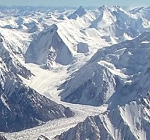In Siachen, the whistling winter wind can turn a temperature of −50 °C to a vicious wind chill of −80 °C where dropping gloves can mean losing fingers. Here, weather takes a far greater toll than the enemy; a man loses 10 years of his life by just being there. This is the reality of the harsh and unforgiving battlefield at the top of the world, that India and Pakistan are fighting over. Indian soldiers permanently man posts above 20,000 feet in these conditions, and have done so for almost 30 years.
Is it worth the trouble? Recently, there has been much talk and Track II agreements on the need to demilitarise the Siachen Glacier. These moves appear to originate mainly from Pakistani Army Chief Gen A.P.Kayani, who lost 139 Pakistani troops in an avalanche at Gayari earlier this year. Many in India, including prolific strategic writers, subscribe to the demilitarization view and a Track II diplomacy initiative has ostensibly been signed.
What has changed in Indo-Pakistan attitudes towards the region – from the 1949 Karachi Agreement and the 1972 Simla Agreement – that the two countries now suddenly realize they were mistaken in holding on to Siachen all along?
The genesis of the conflict lies in the Pakistan-sponsored ‘tribal invasion’ of Kashmir after the Partition when what is today Pakistan Occupied Kashmir (POK) came into existence. The Line of Control delineated by the UN in 1949 became the Karachi Agreement, which did not clearly mention who controlled the glacier, merely stating that from NJ9842 (a map coordinate) the boundary would proceed “thence north to the glaciers.” UN officials presumed there would be no dispute between India and Pakistan over such a cold and barren region. The 1972 Simla Agreement too glossed over the issue.
Prior to 1984, neither India nor Pakistan had any permanent presence in the area. However cartographic aggression by Pakistan, mountaineering expeditions and counter-expeditions by both countries resulted in a conflict which began in 1984 with India’s successful Operation Meghdoot, during which it wrested control of the Siachen Glacier (unoccupied and not demarcated area). India has established control over all of the 70 km-long Siachen Glacier, its tributary glaciers, as well as the three main passes of the Saltoro Ridge immediately west of the glacier. This gives India the tactical advantage of holding the high ground.
After 1984, Pakistanis launched several attempts to displace the Indian forces from these heights, but with little success. The most well known was in 1987, when the attack was masterminded by Pervez Musharraf (later President of Pakistan) heading an elite Special Services Group commando unit. The Pakistan attack was repulsed and the positions remained the same. Naib Subedar Bana Singh, who in a daring daylight raid, assaulted and captured a Pakistan post atop a 22,000 foot (6,700 m) peak, now named Bana Post, after climbing a 457 m (1500 feet) ice cliff face, was awarded the Param Vir Chakra. He lived, but according to government statistics, 846 other Indian soldiers have been killed on the glacier due to weather and enemy action since 1984.
There are strategic and tactical reasons why this desolate and bitterly cold, windswept strip of ice is so important to both countries. There is the ideal of a unified Kashmir, of course, and protection of India’s borders, but also the potential domination of Buddhist Ladakh by the Chinese and further infiltration of terrorists from Pakistan if India was to vacate Siachen. Down to brass tacks, however, it is about sovereignty: India cannot let go of such hard-fought and gained territory.
Demilitarization may seem a noble – or sinister – idea. Recently it was propagated by a group of strategic thinkers with multiple views on how this can be managed. But India must understand the ramifications of such a move:
First, the Line of Control (LoC) does not have the recognition of an international border. It is disputed, volatile and permanently manned by troops. The Siachen Glacier is simply a glossed over extension of the LoC and the line from NJ9842 to Siachen is referred to as the actual ground position line (AGPL), which is exactly that: you own what you occupy. Here, possession is definitely nine-tenths of the law.
Second, in the past Pakistan has shown great duplicity in its approach to disputed territory; when expedient it could easily violate a signed agreement and grab and hold these commanding heights. Expelling intruders is more costly than holding these heights; the Kargil adventure illustrates this dramatically.
Regardless of whether the Track II discussions have resulted in proposals urging for demilitarization of Siachen, there is no substantial national or parliamentary debate on the subject. Signing away such an important tract of territory held at great cost, without a practical dialogue, will be inappropriate and insulting to those Indian soldiers who have held these heights at great cost all these years.
There have been many suggestions on how such demilitarization can be made foolproof to ensure Pakistan does not encroach on posts vacated by India – including the right to take military action. But in this part of the world, might is right and holding these heights is vital.
Sometime in the distant future, when the LoC is converted to an actual border, perhaps India can consider a move to demilitarize Siachen. Till then, India simply has to keep holding it.
Xerxes Adrianwalla is a retired Brigadier of the Indian Army and a regular contributor to Gateway House: Indian Council on Global Relations.
This article was exclusively written for Gateway House: Indian Council on Global Relations. You can read more exclusive content here.
For interview requests with the author, or for permission to republish, please contact outreach@gatewayhouse.in.
© Copyright 2012 Gateway House: Indian Council on Global Relations. All rights reserved. Any unauthorized copying or reproduction is strictly prohibited.


